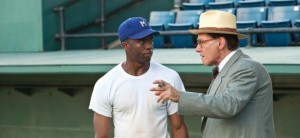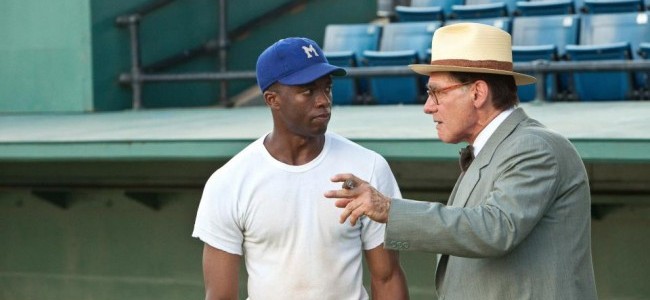 Jackie Robinson is referenced a few times in my upcoming novel, Saving Babe Ruth. I want to take a fresh look at the 42 Movie about the Jackie Robinson story in light of last year’s events involving Penn State and Rutgers. Then I want to draw parallels to my upcoming novel, Saving Babe Ruth.
Jackie Robinson is referenced a few times in my upcoming novel, Saving Babe Ruth. I want to take a fresh look at the 42 Movie about the Jackie Robinson story in light of last year’s events involving Penn State and Rutgers. Then I want to draw parallels to my upcoming novel, Saving Babe Ruth.
Some institutions have problems thrust upon them. The Penn State scandal involving Jerry Sandusky and the Rutgers scandal involving Mike Rice are prime examples.
Both of these institutions failed to recognize that the problem they faced were bigger than one person, bigger than Sandusky or Rice. Their respective failures to address the deeds of these two men— promptly and forcibly—caused them to become ensnared in the scandals themselves. In the end, both institutions gave the appearance of condoning the actions of these two men; as a result, their reputations have been tarnished in the process.
Unlike Penn State or Rutgers, the Brooklyn Dodgers did not have an issue thrust upon their organization. Branch Rickey invited it into his clubhouse; in effect, he invited it into the institution of Major League Baseball. In this context, one can better appreciate why his decision took a large measure of guts despite the business aspect of it.
At the outset, Rickey had a better grasp on his situation than did either Penn State or Rutgers. He knew that the issue of racial segregation was bigger than Jackie Robinson. Penn State, on the other hand, failed to recognize or accept that sexual abuse of children was a bigger issue than Jerry Sandusky. Rutgers failed to recognize or accept that athlete abuse was a far bigger issue than Mike Rice.
Although Rickey’s strategy of refusing to fight back has been rightfully applauded, a careful look at his options reveals that he and Jackie Robison really had no other choice. A military commander engaged in a battle essentially has three choices: he can withdraw, he can attack, or he can stand pat.
Withdrawal was not an option for Rickey because withdrawal was part of the problem—Major League Baseball had been looking the other way at the racial issue for a long time. But to be fair to baseball, a good part of the country had looked the other way too ever since the end of the Civil War when Jim Crow laws replaced slavery as the new form of segregation.
Attacking was not an option for Rickey either. If Robinson fought back, not only would he increase the likelihood of violence against him and his family, his critics would be all over him as a man whose temperament (read “race”) was not suited for professional baseball. In other words, Robinson’s real message would get lost in his reaction.
The only option for Rickey and Robinson was to sand pat, hold ground, and let the baseball play do the talking. You can see in the movie how Robinson’s silence makes a buffoon out of Phillies coach Ben Chapman. Robinson non-responsiveness gave Chapman and others nothing to latch onto in their criticism. They were given no new material to build upon. On top of it, Robinson’s play spoke louder than words. In a verbal vacuum and with Robinson showing his baseball skills, the racial slurs were drowned out. Standing pat was their only option at the time, though Robinson would begin to be more aggressive in responding beginning in 1949.
In failing to identify the magnitude of the problems facing them, Penn State and Rutgers embraced the wrong strategy in addressing them.
In the case of Penn State, the administration (including Joe Paterno) failed to attack the issue at the outset; instead, they opted for a strategy of withdrawal or retreat from the problem. That strategy quickly became a slippery slope. With each passing incident, they found it more and more difficult to attack the problem. If they finally did deal with Sandusky, they would have to explain publicly why they had not acted sooner. After they reached the point of no return, the only thing that was going to address the problems of Penn State was for them to be made public. That finally happened with the arrest, trial and conviction of Jerry Sandusky.
Rutgers did one better than Penn State in at least acknowledging that they had a problem. Before the video was released showing him verbally and physically abusing players, Coach Rice was fined, suspended for a few games, and sent to anger management school. Rutgers strategy was to stand pat— back their coach— while at the same time disciplining him. Rutgers might have thought they were attacking the problem, but if we put Mike Rice into a suit and into any business environment, any reputable employer is going to terminate him (attack the problem) with that video in hand. It’s not that I don’t think Mike Rice should get a second chance (he showed contrition), it’s just that I don’t think any second chance could have been with Rutgers.
I continue to be amazed at the real life parallels between my upcoming novel and events, both past and present. I did not do this by design; it just happened that way.
Inspired by real life events, Saving Babe Ruth is about a man who volunteers to run a youth baseball league. He discovers a situation that discriminates against the ballplayers under his care and decides to address it. In a sense, he is Jackie Robinson and Branch Rickey wrapped up into one. Laced with humor, it’s a story about how he struggles and deals with the steady flow of issues that come at him as a result of his decision. Many of the issues in youth sports will be recognized, but the way they’re thought about will be tested to say the least. At every step, the main character must consider how the decisions he makes impacts his relationship with his community, his baseball team and his family. Choosing between fighting, doing nothing and standing pat are his menu choices every day. As such, I think Saving Babe Ruth would make good reading for the powers that be at both Penn State and Rutgers. You can read more about the novel here.
I’m not going to offer any spoilers for Saving Babe Ruth, but I will suggest there is an even better parallel between Penn State, Rutgers and Indigo Valley High School which is a subject of the novel. Keep that in mind when you have an opportunity to read the book.

